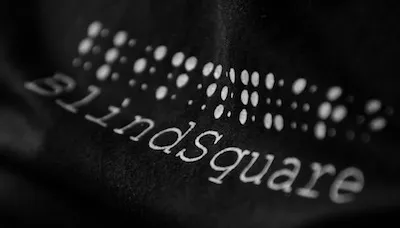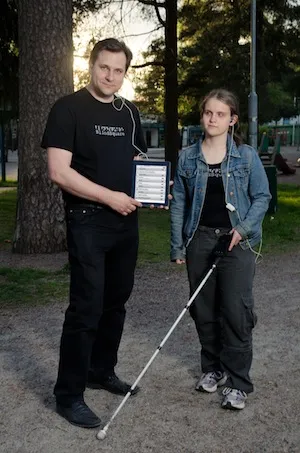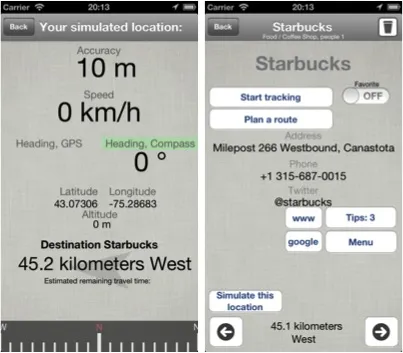Helsinki-based BlindSquare helps the visually impaired go places

Two hundred and eighty five million people, almost four per cent of the global population, are visually impaired worldwide and 39 million of them are blind, according to the World Health Organization. These are the people mobile app, BlindSquare attempts to help. It provides navigation services integrated with data on places and businesses of interest best suited to the user's needs. It conveys all the relevant information by talking to the user.Dubbed as an ‘augmented reality GPS application for the blind’, BlindSquare has received a Global Mobile Award as the Best Mobile Health Product or Service at the 18th Mobile World Congress held in Barcelona.
Ilkka Pirttimaa is the founder of BlindSquare and hails from Helsinki, Finland.
‘I’m not just a GPS’
Competitors like Ariadne GPS and Seeing Eye GPS don’t have crowdsourced information like BlindSquare does. With information about places from Foursquare, BlindSquare can also inform a user of the popularity of the place in question. It also uses OpenStreetMap which allows for global application and is also available in more than 20 languages. With a combination of the two, a user can adjust the radius of his search and get a list of venues by selecting categories or certain preferences. He then has access to details of the venue; that is, contact information, address, twitter feeds, etc. He can activate navigation to get there and even "check in" to that restaurant on Foursquare by shaking the device, once there.
Even though traditional GPS navigations apps like TomTom and Navigon come somewhat close to what BlindSquare does, they don’t necessarily serve the visually impaired. “They can say ‘turn left’, but don’t inform you about the distance to the intersection. Ilkka's strategy is to integrate these solutions so that the user can use BlindSquare and third party navigation apps together to get the best of both worlds.
Working 5 pm to 9 am
Ilkka started programming when he was 13 and today has 30 years of programming experience under his belt. Ilkka’s day job involves working with the Finnish retailing giant, Stockmann, as Head of Technology. But he also has his own company MIPsoft which he founded in1989, but that’s a one-man show. It has published 11 apps on the AppStore, most of them built around open data. The Kyyti app that assists public transport users, received significant traction.

“The idea of BlindSquare came to me when one of my friends posted on my Facebook wall suggesting that I implement my public transportation app (Kyyti) for the blind. I looked into this and noticed big opportunities to bring new services to the visually impaired,” says IIkka.Technology first
Ironically, Ilkka didn’t know of anyone who was visually impaired, but had knowledge about service design. So when he started off in January 2012, he wasn’t answering the ‘what you would need’ question but rather started to build ‘technology first’. He created building blocks for tracking location, producing speech in multiple languages and getting information about surroundings from open data sources like Foursquare.
He started reading blog posts and following the visually impaired on Twitter – this helped with getting familiar with their daily lives. Additionally, his degree from the Helsinki University of Technology, primarily in computer science, usability, cognitive science and service design, lent his design some credibility. He then began to build a global community of beta testers and has 50 at the moment. He has also created a team which helps him in providing end user support, writing instructions, hosting web servers, marketing, creating sound effects etc.
“With three beta testers from Finland, two from the US and one from Australia, I managed to publish a first release on May 2012. I then started to get questions like ‘could you support Hungarian?’ ‘How about Polish?’ I started to build a community of the visually impaired who wanted to help me build this product,” says Ilkka.

Pricey? Nope, worth it“I work only part time on building BlindSquare. But I’ve been able to push 20 new releases during 20-month period, bringing in more than 150 new features. My current target audience is iPhone or iPad users. Android phones will be an interesting platform to consider in the future,” he says.
The app sells for $25 as a one-time fee. The app was initially perceived to be expensive. But having taken the time to build a reputation, BlindSquare users attest to the price being worth it. Nonetheless, Ilkka is exploring a pay-if-you-want model for some features.
The app has 10,000 users in 60 countries and got the initial push when it was featured by Mashable in May 2012.
“My strategy is to continue developing this service together with my end users to ensure that it really works and solves real problems. This will allow for universal acceptance and utility. I haven’t received funding yet but I haven’t had big need for it since sales are growing steadily.”







